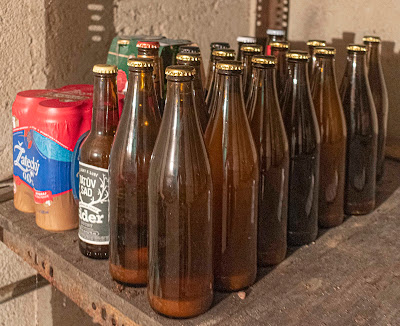One lives and learns. My orchard bears fruit every other year, as it is gloriously untended, unsprayed and otherwise untouched by chemicals or machinery. This year, the bumper crop needs to be brought in and turned to cider quickly. Key takeaways:
● Use smaller demijohns. I've just bought another six of the five-litre sort. They can be filled up to the cork more quickly, so there's less time for the juice to oxidise and go sour. The smaller demijohns can also allow for customised batches (I intend to make one of perry and one of grape wine).
● Picked vs gathered apples. The ones I pick up off the ground (freshly fallen overnight) are ripe. The ones picked off the trees are not quite ripe. There is a difference. The ripe ones have higher sugar content, but produce less juice and more mousse when forced through the juicer. They have yellow skins.The picked apples are juicier, tarter and crisper – you get that satisfying krahhh sound as the juicer mills them. They have green skins. Getting the balance right between the two is critical. Below: off the tree – crisp, tart and juicy, or off the ground – sweet, ripe and sludgy? Bit of both.
● The constant battle with sediment cannot be underestimated. I am running the juice extracted from the juicer through two sieves before it goes into the demijohn, producing a kilo of mousse for each litre of juice. Even so, the bottom 8% to 10% of what ends up at the bottom of the demijohn is sediment. This year, I have been cutting out the apple cores. Last time, I left them in; not only do they add to the sludginess, but they also introduce tannins that are not necessarily beneficial to the taste. And at the end of primary fermentation, the content of the demijohns will need to be sieved yet again. Below: in my cellar, the last dozen bottles of the 2022 production (to the right) – note the sediment at the bottom of the bottles. And this is after they have been decanted for a second time.
● Rather than leaving them in the cellar, this time I am storing the demijohns in my bedroom so I can keep an eye on them. Two years ago, I had one large demijohn fermenting in such a lively manner that it popped the cork and spilled the froth that rises to the top all over the cellar floor, something I discovered a few days later. Now, when I see a build-up of said froth, I can immediately take out the cork and remove the froth with a straw, lowering the level (and at the same time checking the alcohol content).
Below: this is how many apples go to make five litres of cider. Last time, the cores went in as well; this time they stay out. And count them – I make it at least 75 (or 15 apples to the litre). The ratio of green, picked apples to the yellow, gathered apples is evident.
This year's cider season has started much earlier than in 2022, at least a month earlier. Different apple varieties ripen at different times, but this year's apple harvest is unusual in that in started in July.
This time last year:
Getting to Sandomierz by bus and train
This time two years ago:
Inspiration
Food shopping and dietary update
Photos from the Radom Air Show, part 1
This time 12 years ago:
Offloading PKP's risk at W-wa Jeziorki
This time 14 years ago:
Time to be stuffing yourself with fresh fruit
This time 15 years ago:
First notes of autumn in the air
[Still highest summer now in 2024! No sense of autumn yet!]
This time 17 years ago:
Large spider catches fly




No comments:
Post a Comment